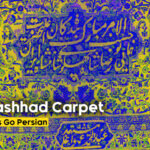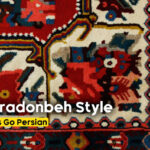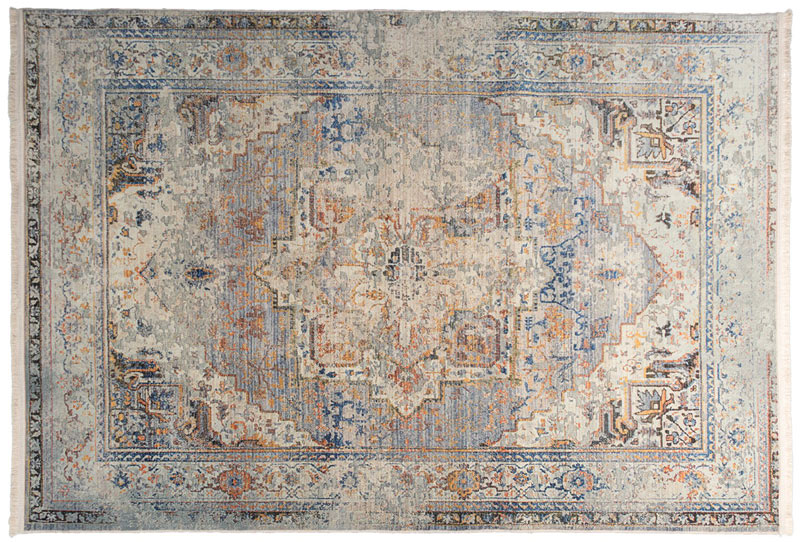
Mashhad Carpets

Faradonbeh Carpets, an Attractive and Popular Design
Charm in Imperfection: The Art and Business of Aged Rug Manufacturing
Vintage-style Rug is among the highly favored rug types due to its striking resemblance to high-quality antique rugs. Given its similarity to rugs with a rich history, it has garnered significant attention. Many rug enthusiasts prefer vintage-style rugs, appreciating the subdued colors and the presence of aging. Consequently, those involved in the rug industry procure vintage-style rugs, applying specific methods, often referred to, to achieve the aged appearance.

Vintage Rugs
Among Rugs, antique and aged handmade rugs hold substantial value. In contrast to machine-made rugs, the older a handmade rug gets and the more signs of wear it exhibits, the higher its value and appeal to a broader clientele.
What is a Vintage-style Rug?
Given the significant value and high prices of aged handmade rugs, those in the rug industry often opt for vintage-style rugs as alternatives to high-aged rugs. The practice of aging rugs has been prevalent not only in contemporary times but also in the past.
In essence, a vintage-style rug refers to a rug subjected to various methods to impart an aged look. This process might involve toning down the original colors, introducing intentional wear in certain areas, or intentionally increasing signs of aging, commonly referred to as “patina.” Currently, vintage-style rugs have a substantial customer base, attracting buyers who are aware that these rugs undergo an artificial aging process. These rugs, known for their unique beauty, add a special charm to homes.

Vintage-style Rugs in the Past
Vintage-style rugs were also of interest in the past. Individuals dissatisfied with the raw and vivid colors of new handmade rugs would resort to aging techniques to give their rugs a vintage appearance. The methods used in the past were relatively straightforward, such as placing rugs in busy streets, markets, or areas with high foot traffic. Alternatively, people would spread rugs in direct sunlight or wash them with water, ash, and wood chips to achieve a vintage appearance. Today, new and traditional methods are employed side by side to age rugs.
The Process of Distressing Rugs:
One of the crucial methods for achieving vintage-style rugs is distressing. Currently, distressing is predominantly carried out for export-oriented rugs. Rug traders distress their rugs to add more value before exporting them as vintage-style rugs.
Advantages of Vintage-style Rugs
Vintage-style rugs offer numerous advantages, leading to an increasing customer base. They are not exclusive to Iran; they also have a significant market in European countries, often referred to in Latin as “vintage.” Due to their aesthetic resemblance to antique handmade rugs, vintage-style rugs are suitable for home use and add a touch of authenticity. Additionally, vintage-style rugs come at a reasonable price compared to antique handmade rugs, making them a fitting choice for those who value tradition and authenticity.

Size and Durability of Vintage-style Rugs
Vintage-style rugs are considered one of the rug types in the industry. They are produced in various patterns and sizes to cater to the preferences of all customers. The flexibility in choosing the desired size ensures there are no limitations based on location. Given the challenging processes vintage-style rugs undergo to attain an aged appearance, they typically belong to rug types with long-lasting durability.
Vintage-style Rugs for Classic Decoration
The use of vintage-style rugs in home decoration garners significant attention. Those inclined towards classic decorations typically prefer handmade and vintage-style rugs over others. The deployment of vintage-style rugs essentially imparts the same beauty that handmade rugs provide to homes. The lightweight nature of these rugs makes them highly convenient for cleaning, adding to their appeal.
Export Benefits of Vintage-style Rugs
The processes of aging and distressing rugs are more commonly applied to those intended for export. The reasons and advantages of these practices include:
- Buyers of vintage-style rugs perceive them as having a long lifespan and high durability. These rugs are believed to possess harmony in colors, akin to aged handmade rugs.
- Distressing can mask flaws that might exist in a rug, such as vivid colors or undesirable materials used
- Second-hand and aged goods selected for export benefit from customs duty exemptions, a rule that extends to vintage-style rugs.
- Facilities available for preferential tariff rates for certain countries can be utilized.

Methods of Producing Vintage-style Rugs
As mentioned, the process of creating vintage-style rugs dates back to ancient times, with traditional methods still employed alongside modern ones. The primary methods for distressing rugs are as follows:
- Rugs are washed using a combination of water, wood ash, and alkali-rich substances.
- Calcium hypochlorite, a chemical compound commercially known as bleach and white powder, is used for chlorination. Its usage is carefully controlled to prevent damage to the rug.
- An effective method involves placing the rug under sunlight or in areas with frequent movement to naturally age over time. This natural approach enhances the rug’s value.
Misconceptions
A common misconception regarding vintage-style rugs is the belief that one can pass off an artificially distressed rug as an antique, even fooling foreign markets. While some sellers might use distressing techniques to give rugs an aged appearance, buyers nowadays can easily distinguish vintage-style rugs from genuinely old ones. Laboratory equipment and testing methods allow for the accurate determination of a rug’s age and fibers.



















